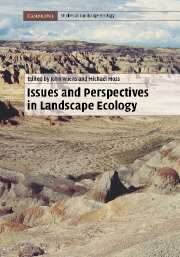Book contents
- Frontmatter
- Contents
- List of contributors
- Preface
- PART I Introductory perspectives
- PART II Theory, experiments, and models in landscape ecology
- PART III Landscape patterns
- 11 Landscape pattern: context and process
- 12 The gradient concept of landscape structure
- 13 Perspectives on the use of land-cover data for ecological investigations
- PART IV Landscape dynamics on multiple scales
- PART V Applications of landscape ecology
- PART VI Cultural perspectives and landscape planning
- PART VII Retrospect and prospect
- Index
- Plate section
- References
12 - The gradient concept of landscape structure
from PART III - Landscape patterns
Published online by Cambridge University Press: 20 November 2009
- Frontmatter
- Contents
- List of contributors
- Preface
- PART I Introductory perspectives
- PART II Theory, experiments, and models in landscape ecology
- PART III Landscape patterns
- 11 Landscape pattern: context and process
- 12 The gradient concept of landscape structure
- 13 Perspectives on the use of land-cover data for ecological investigations
- PART IV Landscape dynamics on multiple scales
- PART V Applications of landscape ecology
- PART VI Cultural perspectives and landscape planning
- PART VII Retrospect and prospect
- Index
- Plate section
- References
Summary
The goal of landscape ecology is to determine where and when spatial and temporal heterogeneity matter, and how they influence processes (Turner, 1989). A fundamental issue in this effort revolves around the choices a researcher makes regarding how to depict and measure heterogeneity, specifically, how these choices influence the “patterns” that will be observed and what mechanisms may be implicated as potential causal factors. Indeed, it is well known that observed patterns and their apparent relationships with response variables often depend upon the scale that is chosen for observation and the rules that are adopted for defining and mapping variables (Wiens, 1989). Thus, success in understanding pattern–process relationships hinges on accurately characterizing heterogeneity in a manner that is relevant to the organism or process under consideration.
In this regard, landscape ecologists have generally adopted a single paradigm – the patch mosaic model of landscape structure (Forman, 1995). Under the patch-mosaic model, a landscape is represented as a collection of discrete patches. Major discontinuities in underlying environmental variation are depicted as discrete boundaries between patches. All other variation is subsumed by the patches and either ignored or assumed to be irrelevant. This model has proven to be quite effective. Specifically, it provides a simplifying organizational framework that facilitates experimental design, analysis, and management consistent with well-established tools (e.g., FRAGSTATS; McGarigal and Marks, 1995) and methodologies (e.g., ANOVA). Indeed, the major axioms of contemporary landscape ecology are built on this perspective (e.g., patch structure matters, patch context matters, pattern varies with scale).
- Type
- Chapter
- Information
- Issues and Perspectives in Landscape Ecology , pp. 112 - 119Publisher: Cambridge University PressPrint publication year: 2005
References
- 133
- Cited by



